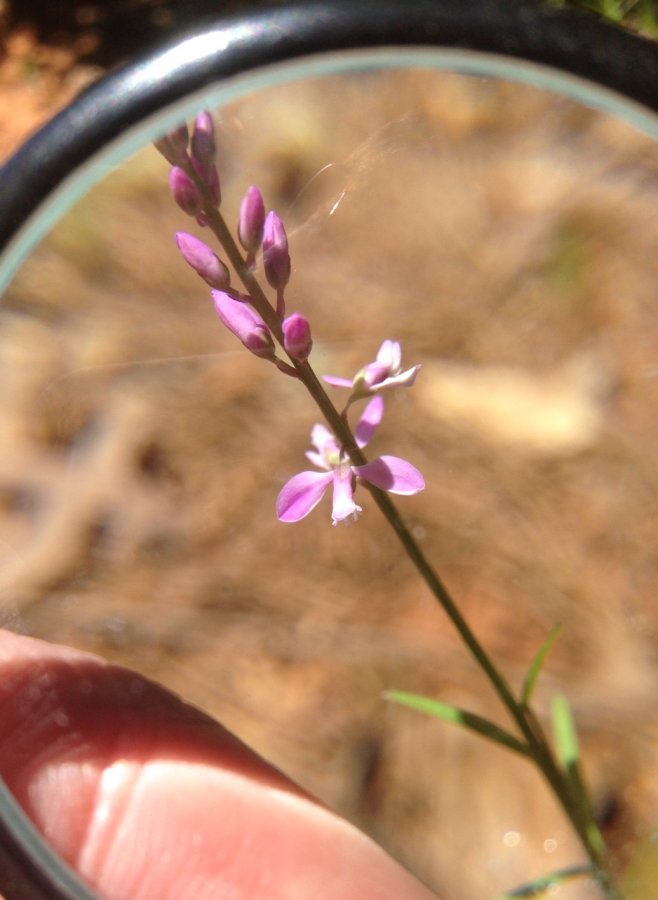Name that plant
Details:
-
Date Photo Taken
05 / 08 / 2020
-
Season Photo Was Taken
Spring
-
Region Photo Was Taken
Southeast
-
City
Athens
-
State
Georgia
-
Posted by
Underdog
Notes:
The plant is about 12 inches high. Haven’t pulled one up to look at the roots. Alternating leaves narrow w/ smooth margins. I seem to recall the stem is square. Stem ends with small purple flowers in a spike.



Comments
laura735 Master Identifier says:
According to sources, these underground flowers are self-pollinated. Check out the included link below with more information. From your ‘field works’ and wonderful photos! we get to see these beautiful and very interesting plants. Great job & thank you Jim! Laura https://books.google.com/books?id=oZVR05eZcPkC&pg=PA437&lpg=PA437&dq=How+Polygala+polygama+cleistogamous+underground+flowers+get+pollinated&source=bl&ots=memmU2aL5F&sig=ACfU3U3LxjwV8C4vHpBdpTuYWEIOxfkEpA&hl=en&sa=X&ved=2ahUKEwjj1pOli8_pAhVO5awKHcYeC34Q6AEwC3oECAkQAQ#v=onepage&q=How%20Polygala%20polygama%20cleistogamous%20underground%20flowers%20get%20pollinated&f=false
May 26th, 2020 at 3:53am
Jim Underwood Green Thumb says:
I’ve been reluctant to pull up any since they aren’t that numerous in the first place. I’ve only seen this plant in one spot on all my walks in the surrounding area. When I see a field full of something I don’t hesitate, but when I only see a few… Very interesting about the underground inflorescence. I didn’t know plants did that. How do they get pollinated?
May 25th, 2020 at 7:53am
laura735 Master Identifier says:
Information of P. senega. https://www.illinoiswildflowers.info/savanna/plants/seneca_snrt.htm
May 23rd, 2020 at 9:09pm
laura735 Master Identifier says:
Polygala polygama underground flowers images. https://michiganflora.net/images.aspx?id=2267
May 23rd, 2020 at 9:09pm
laura735 Master Identifier says:
Hi Jim, appreciate for the feedback. Not having the specimens in person, I’m always ‘guessing’ at the genus and even more ‘guessing’ at their species. To my eyes, yours appears in the genus Polygala. It reported that species roots have rootbeer/winter green aroma (?) Having the specimen in person, you would be the best judge for its species. I hesitate to ask you to pull up anymore roots from this pretty & interesting species as with any wildflowers. Perhaps these provided links can help you further. According to sources, one of the diagnostic keys for P. polygama (Racemed milkwort) is the ‘cleistogamous underground inflorescence/flowers’ as shown in one of the included link. The last provided link includes description the root’s system of P. Seneca. Again, I’m not an expert and Google’s images of P. Polygama’s appear similar(?). Best to you Jim! Link to P. Polygama’s root. https://cdn.plantatlas.org/img/specimens/USF/181179.jpg
May 23rd, 2020 at 9:02pm
Jim Underwood Green Thumb says:
Now that I’ve looked at Polygala root images on Google, I think this is the same plant- Polygala polygama. Some sell the polygala senega roots as herbal remedies, and those are pretty thick taproot looking things. I wish I had some good images of the roots just to make sure, but I think you’ve nailed it. Thanks again Laura!
May 23rd, 2020 at 7:46am
Jim Underwood Green Thumb says:
The flowers and plant look the same, but when I pulled one up, it had a taproot rather than fibrous roots as the illustration shows. Other than that everything else is the same. Square stem, same blossom, same leaf structure and shape.
May 23rd, 2020 at 7:39am
laura735 Master Identifier says:
Maybe one of the milkwort (Polygala)? Possible the racemed milkwort (P. polygama) Check it out and see if you have a match. Best wishes! http://www.namethatplant.net/plantdetail.shtml?plant=1113
May 23rd, 2020 at 2:15am